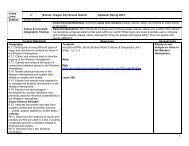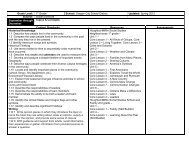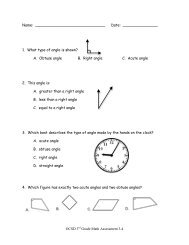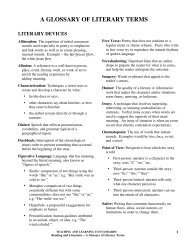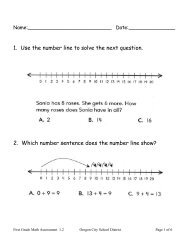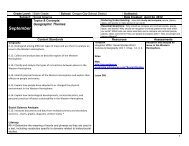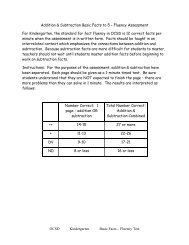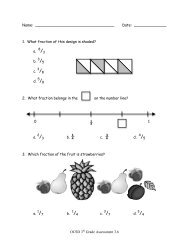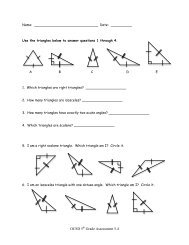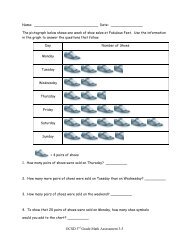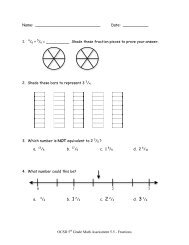You also want an ePaper? Increase the reach of your titles
YUMPU automatically turns print PDFs into web optimized ePapers that Google loves.
UNIT 1: Short sound ofStep One: Short Vowel Soundsa b c d f g h j k l m n p qu r s t v w x y ckb!t dad fat had hat bad lad Sam bag tap pan tan tax hampad can quack yak tag lap nap cap jam gas rat van ranwax cat mat cab sad rag wag map sap rap am fan man anatUNIT 2: SHORT SOUND OF i zb"b did hill in vim bin hid hit pig win bit jig pill bill kissquick will kid rib yip nip rig dim kill rim zip dip big liprid fib lid sit fig fit miss sip rip wig fin fix mill sin Kimtip hip if it tin him pit pin Tim six mixMixed Short Sounds of a and ibat bit bib did dad hat hit hid fat lit gas hill in an Sam bagbig dip dig tip tap hip lip lap ham him pad pat pit pal catsat mad mat mitt miss mass it at if mix Max rig rag tagjam rat van vim six cab zip zap fin fan fix Tim tam rip rapnap nip rag sag wag wig sap sip map yak zig-zagUNIT 3: SHORT SOUND OF oB#b got log top hop bog dog hog fog box hot not nod sodsob pod pot rob cob cot hod bob pop job gob doll dot lottot on off Don mob rod rot fox mop sop1
Mixed Short Sounds of a, i, and oBob bib bob dot tot gob got big bog bag fog fig hog haghot hit hid hat hod had not nit Nat pod pad pit pot pat cobcab nod sob cot cat pop top tap tip tax job jab jib doll dilllot lit rob rib rod rot rat mob on an in log lag off Don boxfox fix fax mop map sop sap sip wag wigUNIT 4: SHORT SOUND OF ud$g rub bun duck jug sun bug fun mug cup rug sum budbut fuss mud tub hut bus gum gun muff tug hug lug nutrut cub gull pup cuff hum run cut up us buzzMixed Short Sound of a, i, o and u.but bat bit kit kid hut hat hot hit dug dig dog bug big bagbog hug hag hog rub rob rod rib van ban bin bun bonduck Dick jug jig jag sun sin fun fan fin fix fax tax ax boxfox mug wag wig rug rag rig sum Sam bud bad bid fussbuzz mud mad mid mod tub tab bus kiss bass boss gumgun muff miff mutt mitt tug tag cup cap cop nut nit not upgull gill cull gal gut got gob pup pop pat pit putt puff cuffhim ham hum run ran Ron cub cob cab cut cat cot codwax wick mix zig-zag log lug lagUNIT 5: SHORT SOUND OF eb%ll tell fell beg peg Ted bet let led fed jet get pet bed pendell red den hen less set vet wet web wed met net sell wellmess men ten keg leg vex meg2
UNIT 10: CONSONANT DIGRAPH: whBLEND wa SOUNDS LIKE w#wha SOUNDS LIKE wh#want watch was water wasp wash whatwhich whisk whack whiff whip whet whiz when whimUNIT 11: ng (ang, ing, ong, ung)bang ding dong wing ping-pong king hung hang thing thongrang rung ring sing sung sang song snug gong gang thing-a-linglong lungUNIT 12: nk (ank, ink, onk, unk)bank bunk link lank chunk chink mink monk wink tank thankthink honk kink dunk dank pink punk rink rank sank sunk sinkinkUNIT 13: INITIAL CONSONANT BLENDS:bl, cl, fl, gl, pl, sc, sk, sm, sl, sn, sp, st, swplan plant flung fling spunk spank flit flat fled smug smogblock black blast blink blank blend bland bled flock flacksmell flag flog smash smelt blush spit spat spot splat splitbliss stuck stock stick stack stamp stump stand flop flip flapstop step club slap slip slop clap clip clop still plod plot platglad gland slam slim slum slosh slash stem click clack clockcluck clinch glass gloss cliff scat scalp sled slid slot slat slitslab stab stub clink clank clunk snip snap skin snob snubskip skid clench snug snag sang sung stiff stuff staff clingclang clung skill skull skiff scuff scoff swell swill swift snuffsniff scum scam scan spin span spun flesh flash flush Scotchsketch flip flap flag flop switch spell spill swing swung swimswam fling flung smack smock swept swap swag swig5
Step Three: Long Vowels (CVE)UNIT 14: WHEN THE FINAL e IS SILENT,THE VOWEL IS USUALLY LONG(long vowel sound of vowel is the same as its name):b&ke cane cape cake date daze fate fade gate gazehate came haze lake lame make mane made matelate game wake name pale quake rate rake pane sakeshame shake same take tame blame flame planestake glade snake chase safe paste gave case fakehaste flake save blaze vase taste waste brave brakecrate crave craze drape grape grave tradeh're theseb(te dime dine dike fine fife dive file five hide hivelime life like mine mite mile nine pike pine pilequite kite ride shine side spike smile slime stileswine spine ripe time tile tide wife wine side pipesize glide while white drive pride prime prizeb)ne cone cope code dote dole dome globe holehome hope joke lone lode lope poke pole quote roderobe rope sole spoke slope smoke note tone totestole mope mole vote woke broke drove probec*be duke dune cute tube tune mule flute prune rulerude plume brute7
Mixed Long Vowel VCE Wordsbake cake cube safe swine note cane came pastespine cape gave ripe tote case time dime dinethose tone tune date fake tile stole daze haste tidewaste fate flake wife mope fade save wine molegate blaze wide vote gaze vase slide woke hatetaste pipe here size duke haze bite glide dune lakewhile cute lame white tube make dike bone banemane fine cone mule made fife cope these matedive drive drove code brave late file dote brokebrake game five dole wake hide dome crate namehive globe crave pale lime hole craze quake lifehome drape rate like hope rake mine joke panemite lone gape grape sake mile lobe grade shamenine lope grave shake snake pike poke pride samepine pole prime take pile quote prize tame quiterode probe tape kite robe trade blame ride ropeflute flame shine sole prune plane side stone rulerole rile stake stoke spike spoke scone rude gladesmile plume slime slope brute chase chose stilesmoke ate use8
Paired Short and Long Vowelspill pile, slop slope, plan plane, Sam same,pick pike, mill mile, lob lobe, pin pine, prim prime,shack shake, rid ride, Sid side, rat rate, hop hope,pal pale, fill file, tack take, grad grade, pan pane,back bake, not note, past paste, cap cape, rip ripe,till tile, mop mope, lack lake, cub cube, Tim time,fad fade, win wine, slid slide, dim dime, din dine,tub tube, cop cope, cam came, Mack make,mad made, cod code, rack rake, jock joke, lick like,at ate, sack sake, slack slake, slim slime, slop slope,pet Pete, top tope, pock poke, fat fateUNIT 15: PHONOGRAMS USING LONG VOWELS:old, olt, oll, ost, oth, ild, indold bold scold cold gold fold told sold mold holdcolt volt molt bolt jolt toll roll post most host bothmild child wild rind wind blind find grind hind kind mindUNIT 16: SHORT WORDS ENDING IN A LONG VOWEL:be he no she go me so we I the9
UNIT 17: INITIAL CONSONANT BLENDS ANDFINAL CONSONANT BLENDS(and/or digraphs, phonograms)ENRICHMENT REVIEWbrag drug drag frog drop drip crunch frump grin brandfresh prank brass French Fred Frank Fran brim drankdrink drunk bring drum dram frock brash brush brunchbranch brink brick grand grant grunt print prim prompress dress grass crab crib trim tram tromp trump trampcrash crush crest crack crust cramp crump crimp gruff trottrod crisp truck track trick trunk trend trust twist grip groggrasp crop drill droll plug pluck plank grad grid blendbland blond blast blest bled glad glum clang clung clingswung swing prong stung sting string strung sprungsprang springMixed Consonant <strong>Blend</strong>s and Non-<strong>Blend</strong>srag drag rug drug dug bass brass dunk drunk rock frockranch branch bran brand rack crack ramp tramp tram tamgas grass rib crib rot trot tot red rend trend tend rasp gapgrasp asp led bled bed last blast end lend blend rut rustcrust runt grunt fog frog ram tram ruff gruff luck pluck letlest blest ant rant grant rink brink rump trump rush brushink rink drink ring bring fed Fred rank Frank rim brimprim lug plug gad grad rum drum an and brand rip dripdip rill drill dill black back\10
Step Six: Irregular SpellingsUNIT 35: UNACCENTED a AT THE BEGINNING OF A WORD.ALSO THE WORD a WHEN NOT USED FOR EMPHASIS:a ajar around asleep about alike arouse astir adrift aheadapart awake afar amuse aside awhileUNIT 36: PHONOGRAMS: ul, ull, ush(u SOUNDS LIKE SHORT oo)careful full fullback put pull push dull bull bush fulfillUNIT 37: SOFT SOUND OF c(before e, i and y) Usually sounds like s: sometimes sh.cent brace mice rice cell chance space cease decide niecenice slice center dance pace spice civil dunce place sincecinder face peace piece twice cyclone fleece trace circusfence prance price prince princess thence cinch Francechoice cigar hence voice acid ice pencil cistern lace acemince raceci = sh: special ocean precious musicianUNIT 38: SOFT SOUND OF g IN dge AND SOMETIMES BEFOREe, i and y.a+e page badge budge bridge ridge plunge dodge lodgeledge smudge change rage edge wedge cage range fudgeginger engage sage stage hedge giraffe fringe gist hugewage nudge giblet barge large urge pledge gyp gypsylunge hinge judge gymnast16
UNIT 39: SILENT gh AND gh SOUNDS LIKE fbright high blight tight might slight thigh fight flightfighter night right plight sigh light moonlighttaught caught daughtergh = f: rough tough laugh laughter laughing enough(In the above words, au and ou are irregular.)UNIT 40: SILENT k, w, t, b and lknee chasten wrist lamb limb kneel glisten wring wrapknelt hasten wrote thumb knight listen wreck knife knitoften wrong calf soften half knot comb walk wreath climbknown know wretch debt knock write numb doubt dumbwren wrench crumb plumbing answer swordUNIT 41: se SOUNDS LIKE zchoose noise please those chose nose rose wise cheesepause rise as ease pose tease has because praise these ishis games tunes hose fuseUNIT 42: ph SOUNDS LIKE felephant prophet phonograph photograph telegraphtelephone nephew pamphlet phone orphan alphabetphonics earphone phonogram17
UNIT 43: FINAL le, tion, sionbattle handle attention partition bundle puzzle actionportion bottle scramble addition station buckle scribbleaffection section circle sprinkle invitation little strugglefoundation expression middle tickle education impressionpickle wiggle mention mission sample nationUNIT 44: ed WITH SHORT eadded ended painted waited acted folded planted countedlanded printed crowded lighted rested graded seated siftedpetted tested needed twisted roasted mendeded SOUNDS LIKE ‘daimed changed saved stayed burned filled rained turnedcalled named rolled sailed peeled pinned kneeled claimedloaned climbed roared wheeled scattered cleaned cannedploweded SOUNDS LIKE ‘tbaked backed picked packed looked locked wished boxedhoped hopped packed camped jumped pitched hitchedliked stopped kissed guessed dropped coaxed checkedshipped scraped dashed milked draped clapped wreckedwrapped stamped dressed knocked18
Step Four: R-Controlled VowelsUnit 18. Phonogram: arUnit 19: Phonogram: orUnit 20: Phonograms: er, ir, ur and sometimes orStep Five: Vowel Digraphs and DiphthongsUnit 21. Vowel Digraph: ai, ayUnit 22. Vowel Digraph: eeUnit 23: Vowel Digraph: ea (three phonemes: long e, short e, long a)Unit 24: Vowel Digraph: ie (two phonemes: long i and long e)Unit 25. Final Vowel y: sound e. Long i in one syllable words.Unit 26. Vowel Digraph: oa, oe (like long o)Unit 27. Digraph ow. Diphthong: owUnit 28. Diphthong ou: Digraph ou (Often irregular; it cansound like short u, short oo, long oo, long o, etc.)Unit 29. Diphthongs: oy, oiUnit 30. Long sound of ooUnit 31. Short sound of ooUnit 32. Vowel Digraphs: aw, auUnit 33. Phonograms: al, allUnit 34. Digraphs: ew, ueStep Six: Irregular SpellingsUnit 35. Unaccented a at the beginning of a word.Also the word a when not used for emphasis.Unit 36. Phonograms: ul, ull, ush (u sound like short oo)Unit 37. Soft sound of c (before e, i, and y)Usually sounds like s: sometimes like sh.Unit 38. Soft sound of g in dge and sometimes before e, i, and y.Unit 39. Silent gh and gh sounds like f.Unit 40. Silent k, w, t, b, and lUnit 42. se sounds like zUnit 42. ph sounds like fUnit 43. Final le, tion, sionUnit 44. ed with short e; ed sounds like ‘d, ed sounds like tThe Table of Contents was prepared by Donald Potter – June 2003 (slight revision1/17/05), Odessa, TX. Further revision 7/16/07 and 9/25/07.20
WHY TEACH BLEND PHONICS?By Hazel Logan LoringIt is my belief that most reading failures are caused by the perfectly normal and very commontendency of many children to look at words from right to left. That this tendency is neitherabnormal nor pathological is evident by the fact that many languages are written from right toleft: Hebrew, Arabic, etc. Before the time of Homer, Greek inscriptions were written in thebustrophedon (pathway of the ox) form: one line from left to right; the next line from right toleft. Oriental languages are written in a vertical manner. There is no “physiologically correct” orincorrect direction in which a language may have been developed.When a child sees a word as a whole he or she has no way of knowing in which direction itshould be looked at until the correct direction is shown. Each child will look at it in whateverdirection his/her tendencies dictate. If the word is in English and the child looks at it from rightto left, he/she is in BIG TROUBLE: “ten” is not the same as “net”; “pat” is not the same as “tap”and if instead of “fun” some children see “nuf” they are headed toward confusion.It has been common practice to teach the word as a whole in the first grade and, then, later, insecond grade, to introduce phonics in the form of word analysis. That is, the child is expected tobreak down the whole word into its component parts and thus deduce the relationship betweenphonemics (sounds) and graphemes (symbols).This method can be reasonably successful if the child has a natural left to right tendency, iscapable of deductive reasoning, and has memorized the whole word accurately. But what of thechildren of equal or even superior intelligence who have a natural right to left tendency? Theycannot deduce correct phoneme/grapheme relationships because they are working from a falsepremise when they see the whole word in a reversed order. Even though they may have 20/20vision they do not see what the teacher sees in the expected order. They hear the phonemes in aleft to right order, while seeing the graphemes from right to left – or perhaps in a confused –direction. This explains why some people think of word analysis as “phony phonics,” and whythe confused child is thought to have a learning disability or “dyslexia.”To be fair, although most techniques in word analysis are useless for the children with directionalproblems – or may even add to the confusion – there is one technique that may be helpful, i.e.,that of teaching of the initial consonant as part of the whole word. As long as care is taken to besure that each child looks at the first letter in the word as the sound is heard, the child will beable to learn the consonant sound. BUT THIS IS NOT ENOUGH. They must be able to learn thevowel sounds and it is imperative that they be given early directional training.I have a daughter who taught for more than eleven years has taught remedial reading in an urbanadult education institute. High school graduates, who have diplomas but who cannot read on asecond grade level, come to her for tutoring. She tells me that most of them know the consonantsounds, but they cannot learn to read until after they have had training in blend phonics.22
Directional guidance is inherent in the system of blend phonics. First we show the student theinitial consonant in isolation and teach its sound. (True, we cannot pronounce the pure sound inisolation but must add a neutral vowel – or schwa - sound. However, this is of no importancebecause the schwa sound will be elided when we make the blend.) Next we show the student thevowel grapheme and teach its sound. Then we blend the two sounds together before adding thenext consonant. There is no way for the child to go except from left to right, and with enoughpractice an automatic left to right habit is acquired. Then, to insure comprehension, it has beenmy practice to have the student use the completed word in a verbal sentence.Directional guidance is also inherent in spelling and writing. They are the other side of the samecoin and much practice should be given in all three skills: spelling, writing and reading, readingand more reading.There is nothing new about the material that we use in teaching blend phonics. It can all be foundin “A Guide to Pronunciation” in the front of any dictionary. Take a look at it and you’ll say,“Wow, teach that to First graders? Impossible!!” It is not surprising that some anti-phonicspersons say that it cannot be done. The trick is to present these seemingly complicated facts in asimplified, streamlined, bare bones version that can be assimilated by a six-year old or younger.There are bound to be differences of opinion as to the order in which the facts should bepresented, and also as to which grapheme/phoneme relationships occur with sufficient frequencyto be considered “regular,” and which are so rare as to be called “irregular.” Even pronunciationsmay vary due to geographical and ethnic differences.English is a wondrous and varied means of communication, but at heart it is simple andconsistent. In first grade we must teach the heart of the subject and not get bogged down withlinguistic niceties. In this way we can provide the basic tool that a person can develop andexpand all through life to enjoy a means of communication to express the most complex thoughtsand feelings, and to understand those of fellow human beings.I found I could provide this tool adequately in its simplest form to my school children in dailyhalf-hour sessions in the first semester of the first grade. By starting in September, children havegained a working knowledge of the 44 phonetic elements in the English language and an overallconcept of its basic structure before winter vacation. While their knowledge may not be l00%perfect, it will be sufficient so that they can, with the teacher's continuing help as needed, utilizethe phonic key to unlock 85% of the words in the English language. (The other 15%, whilelargely regular, contain phonetic irregularities, which sometimes require a little extra help fromthe teacher.)The format of these lessons consists in taking a regular word and building it up phonetically as aclass exercise. Then a child is called on to use it in a sentence. At first it is sometimes practicallynecessary to put the words in the child’s mouth until it is understood what is meant by making upa sentence. As soon as the child catches on, the lessons become lively and spirited. The childrenare eager to participate. (When I inadvertently failed to give a child a turn, I heard about it!)It was something like “Show and Tell” without the “Show.” Instead of using a “Show” object asan inspiration for conversation, we used the key word, which we had built up phonetically.Actually it was a language lesson as well as a reading lesson because the children learned tospeak in complete, correct sentences. The context was limited only by the children's speakingvocabularies and was not confined to sentences like. “Go. go, run. run, see, see” or like “A fat catsat on a mat.”23
I recall one instance when we had sounded out the word “mill.” To avoid missing anyone,ordinarily I called on the children in turn, but this time I simply had to break the rule to call onthe little fellow who was waving his hand frantically and just bursting to tell us something. Heblurted out, “My daddy has a sawmill.” Now that’s what I call reading with comprehension!True, we read only one word at a time but it was always phonetically regular and there was noguesswork. By the time we had completed the 44 Units, the children had the feeling of securitythat comes from knowing that the language was basically an ordered, dependable system. As wecame to words in our books that contained irregularities, they were welcomed as somethingsurprising, unique, different and thus easy to remember.It is possible to teach this work from the chalkboard, but it means that the teacher is half turnedaway from the class. An overhead projector is ideal because the lighted area holds the children’sattention and, since the teacher faces the class directly, there is better control and more eyecontact.As to textbooks with which to implement this study, it would no doubt be easier for the teacherwho is using blend phonics for the first time if phonics-based texts were available, correlatedmore or less with the structured phonics lessons. However, I can vouch from both tutoring andactual classroom experience that any books—old or new—can be used if they are of interest tothe children and suitable for their age level. A few problems may be encountered in the first fourmonths if the books have words that contain phonetic elements that have not as yet beenintroduced in the structured phonics lessons, but it is not too difficult to muddle through thisphase. After the children have been exposed to the 44 phonetic elements, they can tackleanything with a little help from their teacher. Frequently, delighted parents reported to me thattheir children were reading from newspapers and magazines and were devouring library books ata great rate.In the second semester we used much enrichment material. All of the children belonged to ourBook Club. They took home books that they selected during regularly scheduled visits to theschool library. My Room Mother arranged to have a volunteer mother sit in the hallway outsidethe classroom two afternoons a week. The children were excused from the classroom one by oneto give brief book reports to the mother who added a star to the child’s bookmark for each bookread.<strong>Blend</strong> phonics is just about the easiest lesson to teach that can be imagined. No preparation isneeded (except to have at hand a copy of the groups of words as given in the LESSON PLANS);no papers to correct for this phase of the reading lesson; no compulsory tests to be given. Thechildren themselves do most of the work by making up sentences, and thus they learn by doing.It’s easy; it’s inexpensive and it works!24
LESSON PLANS FOR THE TEACHING OFBLEND PHONICS IN FIRST GRADEDo not delay teaching the names of the letters of the alphabet. They are not only necessary inspelling and in the use of the dictionary, the telephone directory and alphabetical filing systems,but they will help in teaching the sounds. The sounds of many consonants are heard in the letters'names and the long sounds of the vowels a, e, i, o and u* are identical to their names.(NOTE: Because the soft sounds of the letters c and g are heard in these letters’ names and thusare easier to teach, we introduce the hard sounds first and provide plenty of opportunity topractice them. Also we make sure the student is familiar with the short sounds of vowels beforewe present the easy-to-teach long sounds.)The vowels are a, e, i, o, u and sometimes y. If a letter is not a vowel, then it is a consonant.In our first lessons in blend phonics (or word building) we teach the sound of a consonant, thenthe short sound of a vowel. The child is taught to look at these letters from left to right(IMPORTANT) as they are presented to him one by one and as the sound is blended. Then weadd another consonant to form a word, which the child uses in a verbal sentence to insurecomprehension.It is true that, when we pronounce the sound of a consonant in isolation, it is necessary to add anextraneous neutral (or schwa) sound. This is of no importance because, when the consonant isblended with the vowel, the schwa sound is elided. For example:b says b-uha says !<strong>Blend</strong> b-uh and ! to make b!The uh sound has disappeared.The great advantage of this technique is the fact that the child has received directional guidanceand has been taught, step-by-step, to look at the word from left to right. This is extremelyimportant because many children have a normal, natural tendency to look at words from right toleft. When shown the word as a whole they may not see what the teacher sees. If shown the wordten the child may see n-e-t. Such reversals cause serious confusion when the child is shownwhole words as is the case in the look-say method, which incorporates no detailed directionalguidance.After you make the blend, ba, add the letter t to form the word bat. Have the child make up averbal sentence using the word bat. If necessary, use leading questions to help the child think ofa sentence.For example: TEACHER: If you have a ball, what do you do with the bat?CHILD: I hit the ball with the bat.Use this format to teach each of the words in Unit I for the short sound of a. Then introduce theshort sound of i and teach the children to sound out as many of the words given in Unit 2 as arenecessary for good practice. Choose the words that will be most interesting to the class and, ofcourse, let the children take turns using each word in a verbal sentence. Continue in the samemanner with short o, short u and short e. Short e may give some difficulty because the sound ofthis letter is easily confused with the short sound of i. (We have all heard some people say "git"or “get” and “ingine” for “engine.”)*u has two long sounds. One is the same as its name; the other is like long oo25
When teaching this work to an individual, use a chalkboard, slate or paper and pencil. Forteaching a class, a chalkboard is adequate but an overhead projector is ideal because the teacheris able to face the class directly.You will notice that the units, if taught in the order given, are cumulative. That is, only one newphonetic element (or related group of elements) is introduced in grapheme/phonemerelationship(s) plus those that were used in the previous units. The work proceeds step by easystep. It is not obligatory to teach phonics in this particular order but this presentation is one thathas proved successful over the years.When your students have completed all 44 units they will have been introduced to all of theregular phonetic elements in the English language. They will then have the tools with which theycan sound out 85% of all words. Most children will need help in implementing this basicknowledge in actual reading and may need help in identifying the graphemes in a word. Forexample, when the student comes to the word, teaching, it may be necessary to help break itdown into its phonetic components: t-ea-ch-ing. Often it takes only a quiet hint: (ea sounds likelong e) to give the child the clue needed.To help students with the 15% of words that contain phonetic irregularities, consult yourdictionary. Write the word as it is given in parentheses following the correct spelling in thedictionary. For example, said (sed). Although students must learn the correct spelling, they cansound out the word as it is given in parentheses.Phonetic irregularities occur most frequently in short, commonly used words. As the child readsmore advanced material the phonic training will become increasingly useful and the child canachieve independence in reading unfamiliar words.The basic work should be presented to a class in one semester (Sept.-Dec.) in half-hour periodsdaily in the first grade. Where large groups of words are given (as in Units 2, 6, 13, 14, etc.)choose only the words that will be most interesting. You do not need to teach all of them.Large word lists have been included to demonstrate how the phonics system provides the key tounlock unlimited numbers of words…unlike the narrow capabilities of the “controlledvocabularies” associated with the look-say method.It is helpful to lay out a schedule at the beginning of the semester, allotting certain time-periodsin which to present words from a given number of units. The objective would be to introduce allof the units before winter vacation. Remember that this formal introduction is merely thefoundation. It starts the child off right by giving strong directional guidance and an overallunderstanding of the phonetic structure of the language. It must be accompanied by—andfollowed by—much practice in writing and reading of books.If one is adapting this material to individual work—rather than a class—it is well to plan on atleast 50 hours in which the basic units are supplemented by exercises in writing and practice inreading.<strong>Phonics</strong>-based textbooks are useful—especially for those who are teaching phonics for the firsttime. However, the lack of such textbooks is no excuse for the failure to teach the material inthese Lesson Plans. Any sort of book may be used. The writer has done it successfully using theonly books at hand: look-say basal readers! When words are encountered which contain soundsthat have not as yet been taught in formal phonics lessons, they may be offered as whole wordsor better still, if the teacher feels up, to it, may be presented as a “preview” of what is to come inthe formal sessions.26
The writer knows from actual classroom experience that, even though the textbook material isnot coordinated with the structured phonics lessons, the problem will solve itself when, in a fewweeks’ time, the class has completed the 44 units in these Lesson Plans. Don’t make a big issueof it. Be patient, pleasant and adaptable during textbook reading lessons but, on the other hand,do not let anything interfere with the daily half-hour formal phonics sessions. At the end of thefirst semester, with the guidance and assistance of the teacher and with supplementary work inwriting and spelling, the children will be able to sound out words in any reading material suitableto their age level.If millage failures and tight budgets—or the prejudice of school administrators or supervisors—preclude the possibility of new phonics-based textbooks, don’t despair. Remember how manypersons in history learned to read with only the Bible or Pilgrim's Progress for textbooks and,though Abraham Lincoln never saw a basal reader, he achieved mastery of the EnglishLanguage.Do plan a tentative schedule before you begin to teach this material. The 44 units in these LessonPlans should be completed in about four months. Do not linger over any one unit. Do not expectthe student to know perfectly the sound in one unit before you go on to the next. After all, thismaterial is arranged to provide a continuing “built-in” review. For example, if you are teachingthe word “toothbrush” in Unit 30, the only new sound is that of long oo. The other sounds, t, th,b, r, u and sh are review elements. When all 44 units have been completed, don’t worry if thestudent has not learned thoroughly every phonetic element that has been presented in thispreliminary work. From now on, every time the student reads any written matter whatsoever itwill constitute a review of the material in these Lesson Plans. It is to be expected that the studentwill need help and reminders for some time after the four months of initial instruction iscompleted. The more practice the student has in reading, the sooner complete mastery of phonicskills will be achieved.27
SEPTEMBERSUN MON TUE WED THR FRI SATUNIT1UNIT1UNIT1UNIT2UNIT3UNIT4UNIT3UNIT3UNIT4UNIT4UNIT5UNIT5Here is a blank calendar for four months onwhich to write in the units on the days youplan to teach.UNIT6UNIT9UNIT6UNIT10UNIT6UNIT11UNIT7UNIT8SAMPLESCHEDULE AND CALENDARFIRST MONTHSECOND MONTHS M T W Th F S S M T W Th F STHIRD MONTHFOURTH MONTHS M T W Th F S S M T W Th F SNow you are ready for the first lesson. You have before you groups of words to guide you but, remember,these are mere skeletons of your lessons. It is your task to inspire the children to put flesh on the bonesand to breathe life into them. Here is a sampling of a proven teaching method:28
THE TEACHER SAYS:The name of this letter is b.It says b-uh.The name of this letter is a.Its short sound is !<strong>Blend</strong> b-uh and !Now we’ll add the letter t that says t-uh.THE TEACHER WRITESbababatWhat is the word?(Pronounce it in class.)CLASS: batI’ll draw a picture of a bat.Johnny, if you have a ball, what do you do withthe bat?JOHNNY: I hit the ball with the bat.Good, let’s sound out another word.This word also starts with b that says b-uh.The next letter is a that says !.<strong>Blend</strong> b-uh and ! together to make b!Now we’ll add the letter g that says(hard sound of g)bababagWhat is the word? (Pronounce the wordbag with the class.) I’ll draw a picture of a bag.Mary, in what does you mother carrygroceries home from the store?MARY: She carries them home in a bag.That’s fine. You have read two words thismorning. Let’s sound another word29
says buha says !<strong>Blend</strong> b-uh and ! to make b!.Now we’ll add d that says d-uh.The word is? Class?bababadCLASS: badBilly, a dog walked on mother’s clean floorwith muddy paws. Was that good?BILLY: No it was bad.(NOTE: If Billy has a dog he will probably wantto tell about something bad that he did.Point to – and pronounce – the new wordwhenever it is used.)Now we’ll start the next with another letter.It’s name is c and it has more than onesound, but today we will learn only thehard sound: k-uh.You remember a; it says !.<strong>Blend</strong> k-uh and ! together to make ca.Now we’ll add the letter p that says p-uh.cacacapThe word, class, is?CLASS: capDonald, what do you wear on your head?DONALD: I wear a cap.30
Continue in this fashion. After you have Finished Unit 1, you need not try to teach all of thewords in the longer units. Choose the words you think will be most interesting to the children.Stay on your schedule so that the work will be completed in about four months.It is important that each child has a turn making up a sentence. This is the “bait” that is used tohold the children's attention. They will not realize that they are sounding out “lists of words”because they will be so intent in expressing their own thoughts as they incorporate the “key”words in sentences.If anyone is bashful or slow in responding, gently ask leading questions to draw the child out.Don’t be afraid to improvise. Talk about the “key” words as much as is needed. Then ask thechild to tell you something about it even if, at first, the response consists only of a parrot versionof your ideas. The children will soon have their own delightful, original sentences. Of course,our purpose is to encourage them to think of the meaning of the “key” words. A six-year oldchild’s verbal vocabulary is said to consist of 5,000 - 10,000 words or more. These lessonsprovide a means of exercising that vocabulary and developing a reading vocabulary at the sametime.Note from Don Potter: Mrs. Loring is correct in saying that the students elide the uh of b-uh, p-uh, d-uh and t-uh. Personally, I recommend pronouncing the t and p with a strong aspirationinstead of the uh (schwa). I pronounce the b and d with a very quick sound, reducing the schwato a bare minimum. Loring also teaches that the letters say the sounds (i.e. b says b-uh). It ismore correct to say that b stands for /b/. Loring, also, says it is not necessary to teach all thewords. I teach all the words since the program moves so fast that I have never found it difficult tocover the whole program in less than four months. I have had students in fifth and sixth gradefinish the program in as little as four to five hours and experience three to four grade level gainsin their reading. My <strong>Blend</strong> <strong>Phonics</strong> <strong>Reader</strong> has even more words than the original program, butthe students always read all the words. 6/4/09.A shorter reader is available for younger students with only the words in Loring’s originalprogram. It is called <strong>Blend</strong> <strong>Phonics</strong> <strong>Reader</strong> Lite and is available on my web site. The longerversion, <strong>Blend</strong> <strong>Phonics</strong> <strong>Reader</strong>, is especially good with older students with severe whole-wordguessing problems because it has more “look-alike” words. The Lite version is good for youngerchildren just learning to read, who have not yet developed a guessing problem.31
Reading Made Easy With <strong>Blend</strong> <strong>Phonics</strong>Unit Progress ChartStudent: ____________________Start Date __________________Teacher ___________________Finish Date _______________Unit 1Step 1Unit 2 Unit 3 Unit 4 Unit 5 Unit 6Step 2Unit 7Unit 8 Unit 9 Unit 10 Unit 11 Unit 12 Unit 13 Unit 14Step 3Unit 15 Unit 16 Unit 17 Unit 18Step 4Unit 19 Unit 20 Unit 21Step 5Unit 22 Unit 23 Unit 24 Unit 25 Unit 26 Unit 27 Unit 28Unit 29 Unit 30 Unit 31 Unit 32 Unit 33 Unit 34 Unit 35Step 6Unit 36 Unit 37 Unit 38 Unit 39 Unit 40 Unit 41 Unit 42Unit 43 Unit 44Step 1: Short Vowels & Consonants Step 4: R-Controlled VowelsStep 2: Consonant <strong>Blend</strong>s & Digraphs Step 5: Vowel Digraphs & DiphthongsStep 3: Long Vowels (VCE) Step 6: Irregular SpellingsCreated by Donald L. Potter, 9/30/07 (www.donpotter.net)32
HAZEL LOGAN LORING(1902-1983)Born in Massachusetts in 1902, Hazel Loring viewed the recent history of reading instructionfrom the unique perspective of one who taught under both the phonics and the “whole word”method.After attending what is now the University of Massachusetts for two years, she had her firstexperience teaching phonics in 1923-24. While raising a family of three children, she maintaineda keen interest in reading problems and later returned to the teaching profession. Mrs. Loringearned her B.S. in Education from Wayne State University, received her Michigan StatePermanent Elementary Certificate, and taught a first grade classroom in Oscoda, Michigan forten years from 1960 to 1970.As a retired teacher she joined the Reading Reform Foundation and served as its MichiganChairman. She was a member of the NRTA and a Retired Member of the NEA.The original edition contained this acknowledgement: For their encouragement and assistance,grateful acknowledgement is made to Mrs. Raymond Rubicam and Ralph W. Lewis, ProfessorEmeritus, Department of Natural Science, Michigan State University.First Printing – January, 1982Second Printing – February, 1983Third Printing – July, 1983The original edition carried the following permission for reproduction:Unlimited reproduction for solely educationalpurposes is encouraged. However, reproductionfor profit may not be made of any part of this publication.Donald Potter’s <strong>Blend</strong> <strong>Phonics</strong> <strong>Reader</strong> was published in 2007. It contains all 1,446 in ReadingMade Easy with <strong>Blend</strong> <strong>Phonics</strong> for First Grade plus other words of similar spelling patterns.There are over 2,080 in the <strong>Reader</strong>. Words of similar configuration are in close proximity tohelp students overcome the whole-word configuration guessing habit. Visit www.donpotter.netand www.blendphoncs.org.Out or respect for Mrs. Loring, I did not change the title. But I have taught people of all ages toread with <strong>Blend</strong> <strong>Phonics</strong>. The book could very well have been titled, Reading Made Easy with<strong>Blend</strong> <strong>Phonics</strong> for All Ages.33
Appendix A80 of the 220 Dolch List WordsAbsent from <strong>Blend</strong> <strong>Phonics</strong>after again always an and any are ask at ate away been before best better buy carry come coulddid do does done don’t down draw eat eight very fall four give going have his I into its laugh livemany myself never of once one only open over own pretty said seven six small some start thetheir here they think three to today together two under up upon us use very warm wash werewhere who would yourNote: Thirty-five of the absent Dolch Sight-Word List words are regular according to Loring’ssystem and forty-five are irregular. The regular words could easily be worked into the book if itwere thought appropriate to make some minor additions to the word lists. Some are regularphonics words that start with a vowel (VC) and were not included in the VCV lists. All of themwill be easy for the student to master once they have mastered <strong>Blend</strong> <strong>Phonics</strong>. These highfrequencyirregular words are easy to remember because they are encountered often in stories.“Of” is the only word that can be considered totally irregular; the others are only slightlyirregular.Here is a useful classification of the omissions:35 Regular words: after an and ask at ate away before best better did down draw eat fall goinghis I its myself never over own pretty six small start the think three under up upon us use45 Irregular words: again always any are been buy carry come could do done does don’t eightvery four give have into live many of once one only open said seven some their here they to todaytogether two very warm was were where who would yourNote: The thirty-five Regular Dolch List words have been included in the <strong>Blend</strong> <strong>Phonics</strong> <strong>Reader</strong>with their correct spelling pattern. Students who have mastered <strong>Blend</strong> <strong>Phonics</strong> will have noproblem learning the 45 irregular Dolch List words. The important thing is to be sure thestudents learn the Dolch words like all the other words, by looking at all the letters from left toright and not just the word shape.Be sure and teach the students Mr. Potter’s Secret of Reading, “Look at all the letters the rightway, and no guessing.”34
PostscriptThe following quote is from Rudolf Flesch’s 1955 Why Johnny Can’t Read and what you can doabout it. This is the most helpful advice I have ever read for helping students with readingproblems.“To begin with, let’s try to isolate Johnny from his word-guessing environment. While he isin school, that is difficult or almost impossible. So the best thing will be to work with him duringthe summer vacations. Let him stop all reading – all attempts to read. Explain to him that nowhe is going to learn to how to read, and that for the time being, books are out. All he’ll get forseveral months are lessons in phonics. … This, incidentally, is important. Take him fully intoyour confidence and explain to him exactly what you are trying to do. Tell him that you aregoing to do something new with him – something entirely different from what his teachers did inschool. Tell him that this is certain to work. Convince him that as soon as he has taken thismedicine he will be cured. … Start him on the phonics lessons. Give him either this book or theonly other book of that type that I know: Remedial Reading Drills by Thorleif G. Hegge, SamuelA. Kirk, and Winfred D. Kirk. Go with him through the Exercises, one by one, always makingsure that he has mastered the previous one before you go on to the next. …Only when you arethrough – or almost through – with the drills and exercises, start him again on reading. At first,let him read aloud to you. Watch like a hawk that he doesn’t guess a single word. Interrupt himevery time he does it and let him work out the word phonetically. He’ll never learn to read if hedoesn’t get over the word-guessing habit.” (115).Hazel Loring’s Reading Made Easy with <strong>Blend</strong> <strong>Phonics</strong> for First Grade hadn’t been written in1955 when Flesch wrote his Johnny; but I am sure that he would have been glad to recommend<strong>Blend</strong> <strong>Phonics</strong> right along with the Hegge-Kirk-Kirk Remedial Reading Drills (available for freeon my web site) and his own 72 Exercises published at the end of his Johnny. Most people arenot aware that Flesch published another book in 1956: Johnny Can Read, containing the sameexercises as in his 1955 book.Reproduction Notice from Donald L. Potter, the author of the <strong>Blend</strong> <strong>Phonics</strong> <strong>Reader</strong>:Unlimited reproduction for solely educational purposes is encouraged. However, reproductionfor profit may not be made of any part of this publication.35
Reading MadeEasy with <strong>Blend</strong> <strong>Phonics</strong>Certificate of Completion<strong>Blend</strong> <strong>Phonics</strong> <strong>Reader</strong>Six-Steps to Reading SuccessCopyright © 2007 by Donald L. PotterStudent: _____________ School: _____________Step <strong>Phonics</strong> Skills Mastered Units Words Date1 Short Vowels and Consonants 1 – 5 297 ______2 Consonant <strong>Blend</strong>s and Digraphs 6 – 13 444 ______3 Long Vowels (VCE) 14 – 17 337 ______4 R-Controlled Vowels 18 – 20 145 ______5 Vowel Digraphs and Diphthongs 21 – 34 525 ______6 Irregular Spellings 35 – 44 336 ______2,084Congratulations to ____________________________ fordemonstrating the ability to read all 2,084 phonics words in Mr.Potter’s <strong>Blend</strong> <strong>Phonics</strong> <strong>Reader</strong>.Teacher: _____________________ Completion Date: _______36



